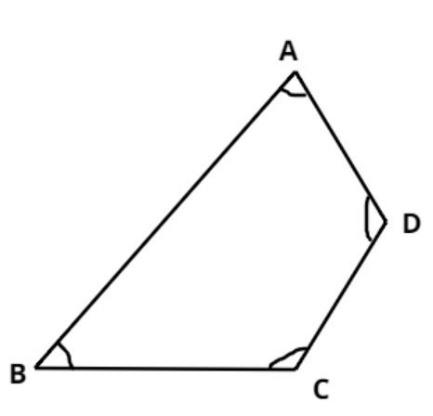
In a quadrilateral ABCD, the angles A, B, C and D are in the ratio 1 : 2 : 3 : 4. Find the measure of each angle of the quadrilateral.
Answer
509.2k+ views
Hint – In this particular question use the concept that in a quadrilateral the sum of all the angles is equal to 360 degrees, and assume any variable for the angle A, and remaining angles are the multiplication of the variable and the respective ratio number so use these concepts to reach he solution of the question.
Complete step by step solution:

Given data:
Angles of quadrilateral A, B, C and D are in the ratio 1 : 2 : 3 : 4.
Therefore,
$\angle A:\angle B:\angle C:\angle D = 1:2:3:4$
Now let, angle A = x.
Therefore, angle B = 2x, angle C = 3x and angle D = 4x.
Now as we all know that in a quadrilateral the sum of all the angles is equal to 360 degrees.
Therefore, sum of all the angles in a quadrilateral = ${360^\circ}$
Therefore, $\angle A + \angle B + \angle C + \angle D = {360^\circ}$
Now substitute the values we have,
Therefore, x + 2x + 3x + 4x = ${360^\circ}$
Now simplify the above equation we have,
Therefore, 10x = ${360^\circ}$
Now divide by 10 throughout we have,
Therefore, x = (${360^\circ}$/10) = ${36^\circ}$
So the value of angle A = ${36^\circ}$
Value of angle B = 2(${36^\circ}$) = ${72^\circ}$
Value of angle C = 3(${36^\circ}$) = ${108^\circ}$
Value of angle D =4(${36^\circ}$) = ${144^\circ}$
So these are the values of the angles of the quadrilateral.
So this is the required answer.
Note –Whenever we face such types of questions the key concept we have to remember is that always recall the conditions on angle in a quadrilateral such as the sum of the opposite angle in a quadrilateral is 180 degrees and the second condition is stated above these conditions are really helpful to solve these types of problems.
Complete step by step solution:

Given data:
Angles of quadrilateral A, B, C and D are in the ratio 1 : 2 : 3 : 4.
Therefore,
$\angle A:\angle B:\angle C:\angle D = 1:2:3:4$
Now let, angle A = x.
Therefore, angle B = 2x, angle C = 3x and angle D = 4x.
Now as we all know that in a quadrilateral the sum of all the angles is equal to 360 degrees.
Therefore, sum of all the angles in a quadrilateral = ${360^\circ}$
Therefore, $\angle A + \angle B + \angle C + \angle D = {360^\circ}$
Now substitute the values we have,
Therefore, x + 2x + 3x + 4x = ${360^\circ}$
Now simplify the above equation we have,
Therefore, 10x = ${360^\circ}$
Now divide by 10 throughout we have,
Therefore, x = (${360^\circ}$/10) = ${36^\circ}$
So the value of angle A = ${36^\circ}$
Value of angle B = 2(${36^\circ}$) = ${72^\circ}$
Value of angle C = 3(${36^\circ}$) = ${108^\circ}$
Value of angle D =4(${36^\circ}$) = ${144^\circ}$
So these are the values of the angles of the quadrilateral.
So this is the required answer.
Note –Whenever we face such types of questions the key concept we have to remember is that always recall the conditions on angle in a quadrilateral such as the sum of the opposite angle in a quadrilateral is 180 degrees and the second condition is stated above these conditions are really helpful to solve these types of problems.
Recently Updated Pages
Master Class 9 Social Science: Engaging Questions & Answers for Success

Master Class 9 Science: Engaging Questions & Answers for Success

Master Class 9 English: Engaging Questions & Answers for Success

Master Class 9 Maths: Engaging Questions & Answers for Success

Master Class 9 General Knowledge: Engaging Questions & Answers for Success

Class 9 Question and Answer - Your Ultimate Solutions Guide

Trending doubts
Which places in India experience sunrise first and class 9 social science CBSE

Fill the blanks with the suitable prepositions 1 The class 9 english CBSE

Write the 6 fundamental rights of India and explain in detail

Difference Between Plant Cell and Animal Cell

What is pollution? How many types of pollution? Define it

What is the Full Form of ISI and RAW




